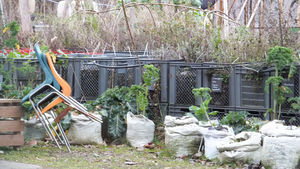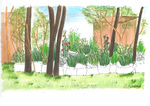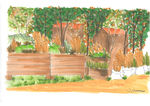Collaborative Design Planting Design Working Group 12: Difference between revisions
| Line 40: | Line 40: | ||
The idea of Prinzessinnengarden came from Robert Shaw, who spent several years in Cuba, and by accident he saw people using urban wastelands to produce local food, those waste lands were given by the city to the people in different places to use them for cultivation. Beside growing vegetables and crops; they also have created places within the gardens where people could meet to socialize and learn from each other. | The idea of Prinzessinnengarden came from Robert Shaw, who spent several years in Cuba, and by accident he saw people using urban wastelands to produce local food, those waste lands were given by the city to the people in different places to use them for cultivation. Beside growing vegetables and crops; they also have created places within the gardens where people could meet to socialize and learn from each other. | ||
After he returned back to Germany he told his friend Marco Clausen about his experience there. Although they were far from their original professions; Robert is film maker and Marco studied history and had experience in bars; together they developed the idea of a kitchen garden in Berlin in 2009. at the beginning, It was not easy to find a piece of wasteland in the middle of the city Berlin, for their farming purpose and especially not for 20-30 years. therefore, they rented a land and use it as much as they can, with creating a system that's able to move( Mobile Farm ). | After he returned back to Germany he told his friend Marco Clausen about his experience there. Although they were far from their original professions; Robert is film maker and Marco studied history and had experience in bars; together they developed the idea of a kitchen garden in Berlin in 2009. at the beginning, It was not easy to find a piece of wasteland in the middle of the city Berlin, for their farming purpose and especially not for 20-30 years. therefore, they rented a land and use it as much as they can, with creating a system that's able to move( Mobile Farm ). Plastic crates and rice bags were chosen for their new mobile system, and they were suitable for the nomadic green feature. | ||
The Prinzessinnengarten is located At the Moritzplatz in Berlin, a busy roundabout in the center of bustling Kreuzberg; it’s a public property of an almost 6000 square feet area. In summer of 2009, the two founders rented this piece of land from the Real Estate Fund Berlin. Over a thousand supporters have helped the site to grow from an ugly vacant lot to a paradise. Without previous expertise, with little money and armed with the idea of communally used garden in the center of the city, inspired by a trip to Cuba, they began in summer 2009 to send down the first roots of a flourishing garden between cement and rubble. About 500 different types of herbs and vegetables are growing here. A diversity of plants is growing here as well as a diversity of social relations. People of different origins and of different ages meet and exchange their knowledge and their experience. | The Prinzessinnengarten is located At the Moritzplatz in Berlin, a busy roundabout in the center of bustling Kreuzberg; it’s a public property of an almost 6000 square feet area. In summer of 2009, the two founders rented this piece of land from the Real Estate Fund Berlin. Over a thousand supporters have helped the site to grow from an ugly vacant lot to a paradise. Without previous expertise, with little money and armed with the idea of communally used garden in the center of the city, inspired by a trip to Cuba, they began in summer 2009 to send down the first roots of a flourishing garden between cement and rubble. About 500 different types of herbs and vegetables are growing here. A diversity of plants is growing here as well as a diversity of social relations. People of different origins and of different ages meet and exchange their knowledge and their experience. | ||
Revision as of 11:04, 16 January 2014
---> back to group page working group 12
The `Prinzessinnengärten` in Berlin as example for Urban Gardening
| Name | Prinzessinnengärten | |
| Location | Berlin | |
| Country | Germany | |
| Authors | Dorothea Eisenmann, Razan Alsoud | |

| ||
|
| ||
Landscape and/or urban context of your case
- Biogeography, cultural features, overall character, history and dynamics
- you can keep this short
- Illustration: Map; sketches; short descriptive analyses
Prinzessinnengarten is an example of social and ecological urban agriculture; which plays a key role in two challenges: urbanization and food security. It can provide an important contribution to sustainable, resilient urban development, creation and maintenance of multifunctional urban landscapes.
The idea of Prinzessinnengarden came from Robert Shaw, who spent several years in Cuba, and by accident he saw people using urban wastelands to produce local food, those waste lands were given by the city to the people in different places to use them for cultivation. Beside growing vegetables and crops; they also have created places within the gardens where people could meet to socialize and learn from each other. After he returned back to Germany he told his friend Marco Clausen about his experience there. Although they were far from their original professions; Robert is film maker and Marco studied history and had experience in bars; together they developed the idea of a kitchen garden in Berlin in 2009. at the beginning, It was not easy to find a piece of wasteland in the middle of the city Berlin, for their farming purpose and especially not for 20-30 years. therefore, they rented a land and use it as much as they can, with creating a system that's able to move( Mobile Farm ). Plastic crates and rice bags were chosen for their new mobile system, and they were suitable for the nomadic green feature.
The Prinzessinnengarten is located At the Moritzplatz in Berlin, a busy roundabout in the center of bustling Kreuzberg; it’s a public property of an almost 6000 square feet area. In summer of 2009, the two founders rented this piece of land from the Real Estate Fund Berlin. Over a thousand supporters have helped the site to grow from an ugly vacant lot to a paradise. Without previous expertise, with little money and armed with the idea of communally used garden in the center of the city, inspired by a trip to Cuba, they began in summer 2009 to send down the first roots of a flourishing garden between cement and rubble. About 500 different types of herbs and vegetables are growing here. A diversity of plants is growing here as well as a diversity of social relations. People of different origins and of different ages meet and exchange their knowledge and their experience. their goal is to create a place of exchange and learning on issues of local and organic cultivation of food, biodiversity, sustainable consumption, the responsible use of resources and a sustainable neighborhood and urban development.
What are the objectives of your design?
Please give a short written argumentation (not more than 150 words). It is ok if you have different or even contradicting objectives within your group. Just make it explicit at the beginning of your process
The gardens create a space for everyone to be a gardener. It is a social, ecological urban agriculture. It is a place to spend time, learn from each other and get in contact with nature and other people. Aims are to learn everything from the very beginning. How to get seeds? How to seed and plant? How to pick? And how to handle the products? Everyone can share his or her experiences or just try something new. Together it is possible to learn more about biodiversity, urban ecology, climate change, recycling and sustainable consumption.
Analytical drawings
Please add four analytical sketches/drawings (or montages/schemes) of your case. Every group member needs to contribute at least one drawing.
- Analytical Drawings
- Yourfilename4.jpg
analytical drawing 4
Projective drawings
Please add four projective sketches/drawings (or montages/schemes), of course with an emphasis on planting design/vegetation aspects. Every group member needs to contribute at least one drawing representing his/her individual ideas.
- Projective Drawings
- Yourfilename1.jpg
projective drawing 1
- Yourfilename2.jpg
projective drawing 2
- Yourfilename3.jpg
projective drawing 3
- Yourfilename4.jpg
projective drawing 4
Design Synthesis
Please analyse the individual approaches presented so far and evaluate their strengths and weaknesses (you may use the SWOTanalysis model). Try to create a synthesis and represent it with a plan and some sketches. You can still use drawings/sketches.
- Design Synthesis Drawings
- Yourfilename1.jpg
synthesis drawing 1
- Yourfilename2.jpg
synthesis drawing 2
- Yourfilename3.jpg
synthesis drawing 3
- Yourfilename4.jpg
synthesis drawing 4
Summary of the collaborative process
Please reflect on your collaborative design process. Which potentials have you encountered? What was most difficult? What does collaborative design mean for you? (approx 150 words).
Image Gallery
You may add a series of images/photos in addition to the sketches/drawings
- Image Gallery
References
* Please make sure that you give proper references of all external resources used.
* Do not use images of which you do not hold the copyright.
* Please add internet links to other resources if necessary.
http://prinzessinnengarten.net/
About categories: You can add more categories with this tag: "", add your categories










